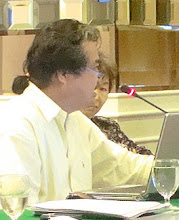Composting the solution
YOU'VE got to smell it to believe it! In San Carlos City, what used to be a stinking open garbage dumpsite lorded by flies and worms is now a rich repository of compost. No stench, no gory picture of rotting animal carcasses, just the soiled remains of empty plastic bags embedded into the compost ready to be pulled out to be recycled elsewhere. And yes, the city government still dumps their waste into this two-hectare site while setting up their new Solid Waste Management Facility. But each day they throw in about two tons of garbage, they also cover these with rice hull to form windrows that measure about eight meters high and five meters wide. The rice hull-covered garbage is then left to itself for six months to cleanse and transform everything biodegradable into a humus substance enough to fertilize a vegetable plot or a flower garden.
And indeed, patches of flower gardens welcome one at the entrance of the site. More than a means to rehabilitate the six-year old dump before it is finally closed, San Carlos City Mayor Eugenio Lacson said they are now convinced of the rice hull technology and will adopt the same method when they finally move to their new solid waste facility. "We're totally convinced of the technology and I believe it is just right for a city like ours, given our existing resources. It is safe and it uses indigenous materials, at the same time solves the requirements of the rice millers. Instead of burning the rice hull, they give it to us and we use it for the dump," he said. The rice hull method was introduced to San Carlos City by the Canadian Executive Service Organization (CESO) in May last year as part of its Comprehensive Solid Waste Master Plan, which the city government adopted in compliance with the requirements of Republic Act 9003 or the Philippine Ecological Solid Waste Management Act of 2000. CESO on the other hand was accessed by a Negros-based non-government organization called Genesys or Global Environment and Nature Ecosystems Society, which the city government tapped to encourage private sector participation in the endeavor. A study undertaken by CESO's consultant Bill Goodings revealed that 80 percent of the city's domestic waste is organic, but that sorting out the garbage as already thrown into the dump was impossible. Thus, they chose to compost the mixed garbage through the natural aerobic process and used rice hull as treatment to bring more air into the waste and the needed "carbon" to stabilize the organic portion of these solid waste. Aerobic bacteria are already present in any organic waste. When the pile becomes malodorous, this means that the oxygen needed by the aerobic bacteria to thrive is depleted and methane is produced. This condition is righted by aerating the waste and adding carbon material such as rice hull to complete the aerobic process. In three days, the eight-meter high windrows of hull-covered mixed garbage start to work as as compost pile. As per the experience of San Carlos City, interior temperature of piles reach 55 degrees Celsius and in that environment, flies, weeds and other pathogens are killed and the odor diminishes to tolerable levels. From here the rice hull is mixed in and left alone for six months. Edgar Lopez, an officer of the city's General Services Department and in charge of the project, said they stick in long mercury thermometers to take the temperature of the pile as this has a bearing on the quality of compost that can be produced. "At 50 to 60 degrees celsius, we can produce better quality compost good for farm requirements," he said. Lopez also started to breed African night crawlers, an earthworm species, right at the dumpsite to support full rehabilitation of the site. Today, even as the city government still uses the same site for their dump, there is a noticeable decline in the presence of recyclables, an improvement, they say, in the way the people of the city manage their garbage.
http://www.inq7.net/reg/2003/nov/08/reg_5-1.htm


No comments:
Post a Comment